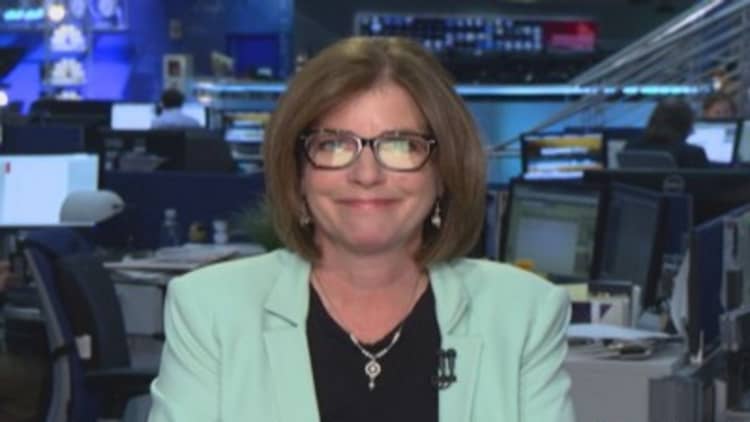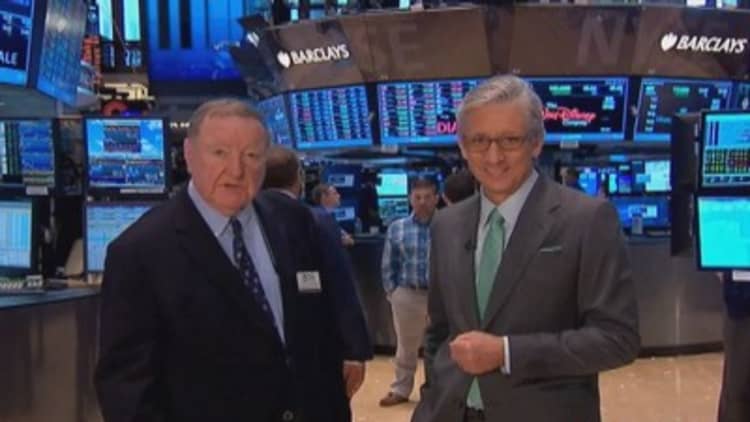
Stocks started the second half of 2014 with healthy gains, and while many analysts expect further advances, the trip higher won't be without challenges.
The was up 4.7 percent for the quarter, its best second-quarter performance since 2009. The S&P has risen in each of the last six quarters, the longest winning streak since the 14 quarterly gains from 1995 to 1998.
"We haven't seen the behavior that suggests a top," said Ari Wald, technical analyst with Oppenheimer Asset Management. "You are going to see pull backs. It's picking your spots, but I think this market can continue to do well."
Read More What's holding back the Dow
The S&P 500 is up 6.1 percent year-to-date, and is outpacing the Dow's 1.5 percent gain.
The second half comes with its own challenges. Analysts say the market may begin to respond to the idea that the Fed is going to raise interest rates, as its quantitative easing program comes to an end. The Fed has been slowing, or tapering its purchases of Treasury securities and mortgages, and that program should end before the end of the year.
"We had a little bit of a taper tantrum last year. I don't suspect it should be a big issue just from the sense they just seem to be on autopilot," said Bill Stone, chief investment strategist at PNC Wealth Management. "…I would suspect a little more indigestion, when the Fed is starting to think about starting to raise short-term rates."
There are also some concerns that inflation could pick up more than the Fed is predicting and force its hand on rate hikes sooner than expected in 2015.
Randy Frederick, managing director, active trading and derivatives at Charles Schwab, said he expects the second half of the year to be much like the first half. He said the market could see smooth sailing as long as there are no large flare ups on the geopolitical front in Ukraine or Iraq.
Ukraine President Poroshenko late Monday called off the ceasefire with pro-Russian separatists. Meanwhile, Iraq's parliament Tuesday is expected to convene to choose a speaker, as that country struggles with an insurgence by a Sunni militant group.
But U.S. politics should be fairly quiet. "Washington is essentially on cruise control until after the election. We're not going to get a whole lot from there that could trip us up," Frederick said.

The economy also could be a factor. While most strategists expect it to grow at a better pace in the second half, there are concerns it may not be as strong as expected. First quarter GDP contracted 2.9 percent, and the second quarter is expected to grow by about 3 percent.
"It will be about deciding which was real and which was the imposter when you look at economic growth in the first and second quarter. The market is believing the second quarter is the re real deal, and we would say the same thing," said Stone, though he said there is still a "sliver of doubt."
Pending home sales showed a strong improvement Monday, the latest piece of housing data to show a winter slump is reversing. The pending sales were at a four-year high.
"Many people seemed worried the housing sector softness seemed persistent, and we could be entering another weak period for the housing market," said Barclays chief U.S. economist Dean Maki. "The most recent data should ease fears that housing was going to be in a persistent downturn. At the same time, it's still a moderate housing recovery. Really nothing has changed."
Read MoreThe doctor is in: Copper rises to 16-week high
Maki expects to see an improvement in ISM manufacturing to 56, from 55.4, when it is released at 10 a.m. Tuesday.
"The regional surveys did pick up in June, and we also saw new orders picking up in the ISM in May and that suggests production should pick up in June," he said.
Maki expects to see vehicle sales Tuesday, falling slightly to an annualized selling rate of 16.3 million, from the unexpectedly strong 16.7 million in May. Construction spending is also reported at 10 a.m.
Read MoreFinancials sector will only get worse: Technician
The big data for the week, however, is the nonfarm payrolls for May, expected Thursday morning, ahead of the July Fourth holiday. Maki expects to see 250,000 jobs, above the 210,000 or so consensus.
"Every indicator we're looking at looks stronger in June than May," Maki.
He does expect growth to pick up and sees 2.5 percent GDP. "The first half has been weak. We think we'll be bouncing back as to what will be an above trend pace," he said.
—By CNBC's Patti Domm


